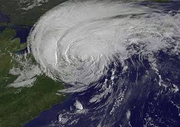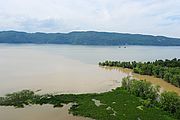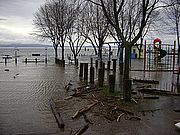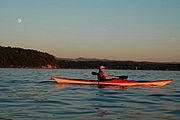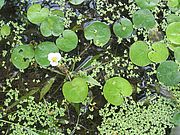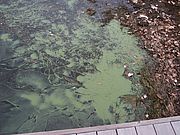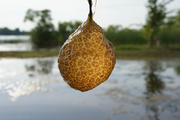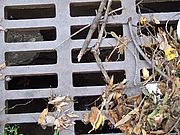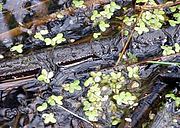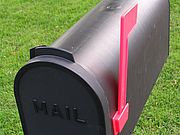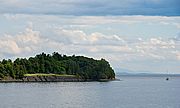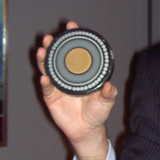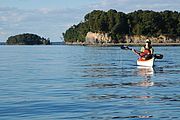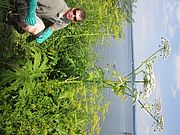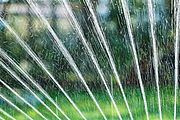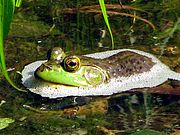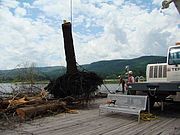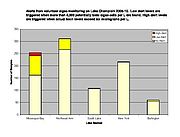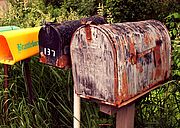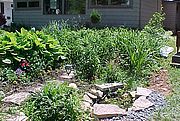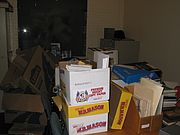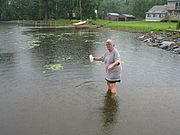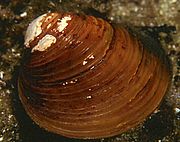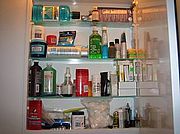Between 7:00 AM and 4:00 PM on Sunday August 28th Lake Champlain rose approximately three feet according to the gauge in Whitehall, NY at the southern end of the lake. Over the same time span the gauge at Rouses Point at the northern end of the lake suggested lake level had dropped by over a foot. The winds of Tropical Storm Irene, with sustained winds over 35 knots (40 mph) and gusts up to 45 knots (52 mph), had pushed the surface water of the lake south where it piled up in Whitehall...MORE Read...
News from Selected Month
Tropical Storm Irene delivered another slug of nutrients and sediments to Lake Champlain along with tremendous quantities of debris causing challenges for navigation. Boaters should use extreme caution on the water. Conditions are particularly treacherous at night. Read...
Lake Champlain was above flood stage for two months this spring. The record flooding that occurred in New York, Vermont and Quebec has led to calls for the governments to ‘do something’. Vermont Governor Peter Shumlin and Quebec Premier Jean Charest have asked President Barack Obama and Canadian Prime Minister Stephen Harper to charge the International Joint Commission (IJC) with researching ways to reduce flooding near Lake Champlain and the Richelieu River. The IJC is responsible for overseeing international boundary waters...MORE Read...
On Friday August 26th the 402 foot center span for the new Champlain Bridge was floated from Port Henry to Crown Point, lifted into place, and secured to the east and west bridge approaches. Now bridge construction enters its home stretch. Outstanding work includes adding the deck of the center span, attaching pedestrian sidewalks outside the arch, and completing various finishing touches. The $69.9 million bridge is expected to be completed before the end of the year according to John Grady, construction engineer for the New York State Department of Transportation. Until the bridge is completed the ferry that provides 24-hour service between Vermont and New York will continue to operate. Click here for visual updates of the bridge construction. Read...
Late summer and early fall are wonderful times to be out on the water. Be sure you have the 2011 edition of the Paddlers’ Trail guidebook in tow. It’s filled with important information for great adventures on the water including site descriptions and chartlets for 39 Trail locations (with access to over 600 campsites), launch site listings, natural history articles, safety and stewardship tips, equipment check lists and more! - And it's available to all members who renew annually for $45 or more. Click here to make an online donation to ensure you have the guidebook in hand for the rest of this paddling season. Happy, safe adventures on the water! Read...
A new population of European frog-bit was discovered during a plant survey in Missisquoi Bay. Researchers from LCC and Arrowwood Environmental had been surveying the plant communities (video) when they came across the population in an isolated embayment near the mouth of Dead Creek on the eastern side of Missisquoi Bay. “It’s a small population with a few scattered individual plants which we removed,” reported LCC Staff Scientist Mike Winslow.
The plant survey is funded by a grant to LCC from the Lake Champlain Basin Program. LCC’s aquatic mapping and removal project is proactive, seeking and eradicating invasive plant populations before they become established. Once a species becomes established, eradication is infeasible in most situations. Our work can prevent species from expanding in the lake. By the end of August, more than half of the Missisquoi Bay plant community had been sampled. Work is expected to continue through September. Read...
The 2011 blue-green algae monitoring season is winding down. This year following spring flooding, blooms in Missisquoi Bay were extensive and thick. Additional persistent blooms were found in St. Albans Bay and sporadic blooms occurred throughout other portions of the lake. For information about the latest status of algae blooms on Lake Champlain visit LCC’s website or the Vermont Department of Health’s blue green algae page.
Each summer since 2004 LCC has partnered with the University of Vermont Rubenstein Lab, to expand blue green algae monitoring on Lake Champlain. LCC helps train and oversee citizen monitors who take weekly water samples from select shoreline areas. We also monitor several shoreline beaches, do visual site checks at additional locations, and serve as a first responder when blooms are underway. This award-winning program, which LCC initiated, provides critical data on where and when blooms are happening. The information we gather is used by public health officials to assess whether the water is safe for swimming. Our dedicated group of volunteer monitors go out once per week from early July through Labor Day to collect samples and take them to designated drop-off locations. Read...
Brown jelly-like blobs have been reported from various places around Lake Champlain this summer. The patterning on the surface of the blobs makes them resemble brains or diseased tree branches. These are actually colonies of sessile invertebrate animals called bryozoans. While the blobs may range from golf ball to melon-sized, each individual in the colony is microscopic. Most bryozoan species live in marine environments, but 50 species are known from freshwater including 21 from North America. The species most commonly observed in Lake Champlain is probably Pectinatella magnifica. Bryozoans tend to grow on wood or other vegetation in areas where the water is quiet. They do not tolerate polluted conditions and require fairly high oxygen levels in the water. Occasional summer outbreaks have been recorded on other waterbodies, but it is unclear why they happen. Read...
One small step you can take to minimize damage from storms to local roads and waterways including Lake Champlain is to clear any storm drains in your neighborhood. When storm drains clog, the water that they are designed to collect bypasses the drains and erodes at road beds. In addition to weakening the road the eroded soils wash into water bodies adding to the pollution load from storms. Unclog the drains by simply removing any debris on the grate or blocking water’s access to the grate. It’s a small step, but every little bit helps. Read...
As the kayak glides through the still water of a marshy bay it parts the green verdure floating on top. A bullfrog sits camouflaged amidst the tiny leaves. This is no algae bloom. Each spot of green is a separate little plant, the smallest of the rooted plants. Duckweed.
Due to their small size, duckweeds are often confused with algae. Like algae they can proliferate and cover stagnant regions of nutrient rich water. Quiet backwater bays, stormwater ponds, farm ponds, and slow-moving lowland streams can be filled with the plants. If the water is not stagnant, duckweeds simply blow away and the population never builds up. So, unlike algae blooms, which can appear anywhere on the lake, duckweeds’ range is more restricted... Read...
If you’ve had an address change recently, please send us an email so we can update your files and ensure you receive news on lake issues and LCC’s work. Our primary form of communication with members is through email. By mailing electronically we save time and resources and reinforce the stewardship ethic of our mission. We don’t give away or sell email addresses. To ensure that our email messages get through to your inbox, please add lcc@lakechamplaincommittee.org and the domain enews.lakechamplaincommittee.org to your safe/allowed list and address book. Thanks! Read...
The owners of a tugboat that sank on Lake Champlain in 1963, the week before President Kennedy’s assassination, has agreed to begin efforts to remove any residual fuel left on the boat. The tug, an oil tanker, struck Schuyler Reef and sank in waters over 100’ deep. According to an AP report, McAllister Towing and Transportation Co. is negotiating with a Buffalo company to send a diver to the wreck to see if any fuel remains aboard. The expedition had originally been planned for late May, but high lake levels forced a delay. Read...
Transmission Developers, Inc. (TDI), a Canadian Company, is continuing to push for an electric power line to be placed on the bottom of Lake Champlain and the Hudson River.
The line would provide energy for the New York City area. TDI has made some changes in their preliminary design so that they would now avoid wetlands in the narrow southern part of Lake Champlain routing the line overland in that stretch. LCC had raised this concern in meetings regarding the project. TDI is currently making its case before the New York Public Service Commission and a joint proposal is anticipated by August 12th. In a recent press release the company touted support from 20 members of the New York State Congressional Delegation including Representative Bill Owens of Plattsburgh. Read...
The 2011 edition of the Lake Champlain Paddlers' Trail Guidebook and Stewardship Manual is out! It’s jam-packed with important information for great adventures on the water including site descriptions and chartlets for 39 Trail locations (with access to over 600 campsites), launch site listings, natural history articles, safety and stewardship tips, equipment check lists and more! - And it's available to all members who renew annually for $40 or more. Click here to make an online donation to ensure you have the guidebook in hand for the rest of this paddling season. Sincere thanks to all the federal, state, and municipal staff and the many volunteers who worked tirelessly to clean up recreation areas and Trail sites and ready them for the season. In June many Trail locations were still under water or affected by the flooding. Without the tremendous effort of many people, we would not have been able to open as many Trail sites this year. Our sincere thanks to all who participated in the clean up. Here’s to happy, safe adventures on the water! Read...
An astute resident found a new population of an invasive species near the ferry dock in Essex, NY. The plant, giant hogweed, is a federally listed noxious weed within the carrot family. Exposure to its sap can cause severe skin irritation, blistering, scarring and even blindness. The plant can grow up to 12 feet in height. Dr. Alan V. Tasker, of the U.S. Department of Agriculture’s National Noxious Weed Program, says people can distinguish giant hogweed from other species of the carrot family, not only by its gargantuan size, but by its purple-splotched, hairy stems. “Cow parsnip stems have a more ‘furry’ look to them, whereas the hogweed has long, white hairs which are most pronounced at the base of the leaf petiole (stem). But the foliage of cow parsnips and giant hogweeds before they send up flower stalks is so similar it’s almost impossible to tell them apart.”
Giant hogweed is a native of the Caucasus Mountain region between the Black and Caspian Seas. It was introduced to Europe and the United Kingdom in the late nineteenth century and to the United States in the early twentieth century as an ornamental garden plant. It has become established in New York, Pennsylvania, Ohio, Maryland, Oregon, Washington, Michigan, Virginia, Vermont, New Hampshire and Maine. Seeds may also be distributed by birds and waterways, and can remain viable for over 10 years.
NY DEC working in collaboration with town officials and The Nature Conservancy began immediate efforts to eradicate the Essex population and prevent its spread. Read...
Summer is here. Swimmers no longer need to brave the cold as the lake has warmed up over 700 F according to USGS gauges. The lake level, though still high, has receded well below flood stage. The first harvests of the gardens are in and gardeners need to turn their attention to weeding and watering.
Summer’s rising temperatures often coincide with rising water use. “Peak” water use describes the time of year when residential water use is at its highest due to an increase in outdoor water use, usually from late July through early August. The amount of water homeowners use to keep their lawns green or fill their backyard pools spikes during this season—to the tune of about four times as much water or more than the rest of the year. Some homes use as much as 3,000 gallons on a peak day, or the equivalent of leaving a garden hose running for nearly 8 hours. Read...
~ Step on it: Grass doesn’t always need water just because it’s hot out. Step on the lawn, and if the grass springs back, then it doesn’t need water. An inexpensive soil moisture sensor can also show the amount of moisture at the plant’s roots and discourage overwatering.
~ Time it right: It’s best to water lawns and landscapes in the early morning and late evening because significant amounts of water can be lost due to evaporation at other times of day.
~ Tune up your system: Inspect any irrigation systems you might have and check for leaks and broken or clogged sprinkler heads. Fix sprinkler heads that are broken or spraying on the street or driveway.
~ Give your hose a break: Sweep driveways, sidewalks, and steps rather than hosing them off. And don’t forget to check for leaks at your spigot connection and tighten as necessary.
~ Leave it long: Raise your lawn mower blade. Longer grass promotes deeper root growth, resulting in a more drought resistant lawn, reduced evaporation, and fewer weeds. Read...
In early July gray tree frogs can still be heard calling for mates, but by the end of the month bullfrog (jug-o-rum) and green frog (like a single tong from a banjo string) calls become more prominent. Tree frogs breed earlier in the season because they utilize vernal pools for laying eggs. The advantage of vernal pools is that they hold fewer predators. The disadvantage is that the eggs must hatch and the tadpoles mature before the pools dry up. In contrast bullfrog and green frog tadpoles breed in permanent bodies of water. Their tadpoles will spend at least one winter in the water before maturing. Read...
The Albany Times Union reported that this year’s lake flooding has led to some navigational challenges in the South Lake. Portions of the shoreline have broken off creating ‘islands’ as large as half an acre within navigation channels. In mid-July, the US Army Corps of Engineers used a floating crane to remove trees boulders and other debris from the lake at Maple Bend in Dresden; the result of a landslide reported on July 6th. Additional large segments of shoreline broke free and started floating in South Bay. According to Dave Winchell of the New York Department of Environmental Conservation, the largest of these segments has come to rest against a jetty leading to the South Bay fishing pier, while it is unclear what happened to the other pieces. Read...
LCC began its ninth season of our award-winning blue-green algae monitoring program in early July. Volunteer monitors take samples once per week at selected locations around the lake. The samples are then analyzed by the Rubenstein School of Natural Resources at the University of Vermont for the presence of blue-green algae and any toxins they might produce. The information generated is used to inform public health officials of any potentially toxic algae blooms on the lake. The monitoring season runs from the fourth of July through Labor Day.
Many thanks to all the volunteers that help us with monitoring efforts :Allan Carpenter (Red Rocks), Stephanie Kurchberg (North Beach), Catherine Brooks (Ferrisburgh Town Beach), Deb Diemand (Shoreham), Jon McBride and Amy Calkins (Begg’s Park), Bob Murphy (Willsboro Bay), Mary Simmers, Gerry Duprey, and Gerry O’Conner (Point Au Roche), Gary Molinski (Rouses Point), Doug Ward (North Hero State Park), Sally and Jim Brabham (Carry Bay), Larry and Jeannine Pratt (Pelots Bay), David Greenough (City Bay), Eric Wolinsky and Keith Peterson (St. Albans Bay Park), Kaylee Pollander (Maquam Shore), Martha Perry (Donaldson Point), Mike Roach (Shipyard), Bob Martell (Chapman Bay), Bill Magnus (Rock River and High Rocks). Read...
We’re delighted to note that LCC’s Blue Green Algae monitoring program received the Citizen Scientist Green Mountain Environmental Award. The awards were created by ECHO Lake Aquarium and Science Center and FreePressMedia to recognize environmental stewards and their initiatives that have shaped, inspired, encouraged and supported successful and long-term leadership of Vermont’s rich and diverse natural environment. LCC’s monitoring program provides weekly input to health managers during the summer recreation season about the location, density, and persistence of algae blooms and algae toxins. The information helps public health managers make informed decisions about when and where algae blooms may require beach closings. The volunteers develop a greater knowledge of the lake and become resources within their community for anyone with questions about algae blooms. Additionally, the data gathered by volunteers is adding to the understanding of what triggers algae blooms so we’re better able to prevent them in the future.
“You and the Lake Champlain Committee have been vital to the preservation of our great Lake. The citizen volunteer algae monitoring program is just one example of decades of environmental leadership by LCC,” noted US Senator Patrick Leahy in a congratulatory letter to LCC Executive Director Lori Fisher. “Thank you for your many contributions.” LCC extends our deep appreciation to ECHO and FreePressMedia for the award and $1,000 cash prize to support our work and to our dedicated blue green algae citizen monitors and partner agencies. Hats off to Dr. Mary Watzin and Susan Fuller of the Rubenstein School of Environment and Natural Resources at the University of Vermont, Linda Boccuzzo of the Vermont Department of Health, Angela Shambaugh of the Vermont Department of Environmental Conservation, and Bill Howland, Colleen Hickey, Eric Howe, Kathy Jarvis, and Meg Modley of the Lake Champlain Basin Program. There wouldn’t be a monitoring program without our dedicated group of “citizen scientists”. We applaud past and present volunteers Anne August, Jennifer Bowman, Jim and Sally Brabham, Catherine Brooks, Al Carpenter, Chris Case, Carson Cornbrooks, Ed and Joan Comolli, Deborah Diemand, Gerry Duprey, Marc Eisenhower, Ryan Garber, Lawrence Gillet, Dave Greenough, Sally Littlefield, Joan Louie, Bill Magnus, Bob Martell, Jon McBride, Gary Molinski, Jerry Morong, Bob Murphy, Nate Otis, Martha Perry, Keith Peterson, Larry and Jeannine Pratt, Mary Simmers, Mike Roach, Micah Rose, Stan Tuller, Mark Sweeney, Cheryl Ward, Doug Ward, and Albee Westover. Read...
If you’ve had an address change recently, please send us an email so we can update your files and ensure you receive news on lake issues and LCC’s work. Our primary form of communication with members is through email. By mailing electronically we save time and resources and reinforce the stewardship ethic of our mission. We don’t give away or sell email addresses. To ensure that our email messages get through to your inbox, please add lcc@lakechamplaincommittee.org and the domain enews.lakechamplaincommittee.org to your safe/allowed list and address book. Thanks! Read...
Want to add to your properties’ curb appeal and protect Lake Champlain and other water ways? The Lake Champlain Committee encourages designing a water-smart yard that puts nature to work creating healthy lawns and gardens. Click on the title for resources and tips. Read...
We spent much of the last month moving the Lake Champlain Committee office. The move gave us an opportunity to weed through our files and cull much of the material that no longer seems relevant. It’s amazing how many papers accumulate over time. Homes and offices build up waste and periodic cleansings rid the space of excesses. So what about the lake? What happens to the excesses that fill-up Lake Champlain?
For over 10,000 years, sediments have been pouring into Lake Champlain. The pace of sedimentation has increased dramatically with development of the landscape, but it is not a new phenomenon. Much of what is now the Champlain Valley used to be part of Lake Champlain. Slowly, the lake fills in. Read...
Focus some of your spring cleaning efforts on shoreline areas this year. Lake flooding has washed up tons of debris around the lake. Extra hands will be needed to clear trash and prepare recreation areas for summer. Consider contacting the managers of a public lakeside recreation area near you and volunteering your services for when the waters recede. Read...
LCC is gearing up for the 2011 blue-green algae monitoring season. The LCC shoreline monitoring has been on-going since 2004. Our monitoring efforts concentrate on Missisquoi Bay and the northern lake where we know blooms are most common and most severe. We also have a limited number of sampling locations along the Main Lake and South Lake. If you are interested in conducting regular visual observations of water quality in your section of the lake contact LCC staff scientist Mike Winslow. Read...
Efforts are underway in Lake George to use benthic mats to exterminate a population of Asian clam. The Asian clam, Corbicula fluminea, is a small bivalve that is native to southern Asia, the eastern Mediterranean, and Australia. They are small, usually less than 1.5 inches in size, and have a light tan or brown shell (color varies) with distinctive concentric ridges. The Lake George population was discovered just last year, and is thought to be small enough that control efforts can lead to complete eradication. The benthic mats used for control are rolled out on the lake bottom and weighted down with steel rebar. The mats are expected to suffocate any Asian clams beneath them within 45-days. Read...
Near the end of the session a bill was introduced that proposed a number of programs and changes designed to improve water quality and the management of Lake Champlain. The specifics of the bill will clearly change as it moves forward. The bill was meant to begin a conversation about what legislative changes might be necessary. LCC has begun discussions with other groups about how to best shape this bill in the next year of the biennium. Read...
The Vermont House passed a bill that would strengthen participation of citizens in environmental enforcement decisions. The bill allows a 30-day public comment period on any penalties assessed with regard to environmental violations, and allows for anyone who does comment to challenge overly lenient penalties that might be assessed. The bill still needs to be considered in the Senate next year. Read...
The Vermont legislature passed a bill that will help facilitate drug take-back programs at pharmacies. Unwanted pharmaceuticals present a potential water quality hazard when they are carelessly dumped down the toilet. In an ideal situation consumers would be able to return unused pharmaceuticals to the pharmacy where they purchased them for proper disposal. However, such drug take-backs are complicated by a maze of federal and state regulations designed to keep the drugs off the black market. LCC ensured that voices of local law enforcement were heard when the bill was first considered in the House. The new Vermont law assures that consumers can lawfully deliver unused medications to properly authorized authorities for the purpose of disposal. Our thanks to Representative David Deen for sponsoring this bill and shepherding it through the Statehouse. Read...

